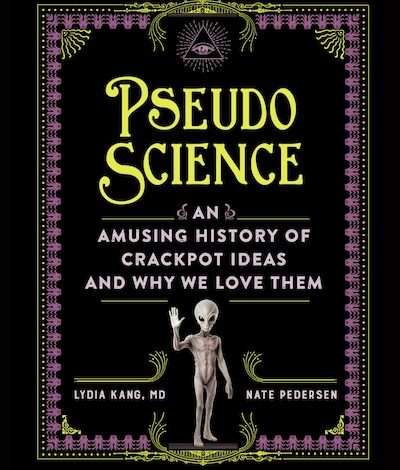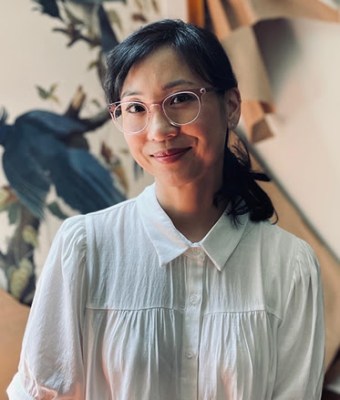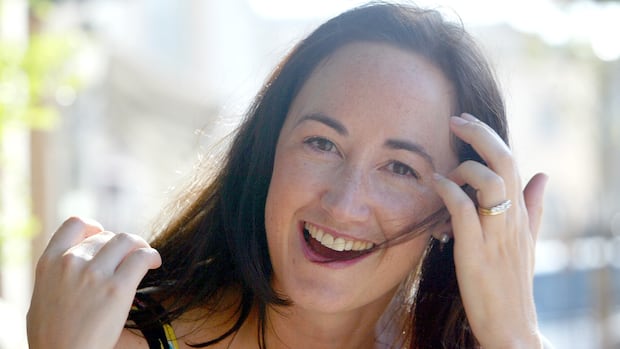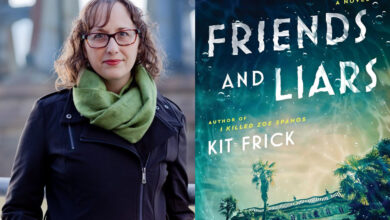Q&A with RPCS Alum Lydia Kang, Author of ‘Pseudoscience’

As a child, I used to pore over books that answered common questions like Why do we yawn? and Why is the sky blue? For a year or two, a thick volume called Tell Me Why was my rainy day go-to. It sated my curiosity about so many things.
Reading Lydia Kang, MD, and Nate Pedersen’s newest nonfiction compendium, Pseudoscience: An Amusing History of Crackpot Ideas and Why We Love Them, brought back those same feelings of satisfaction. It’s a friendly, informative, trustworthy guide to some of the bonkers ideas people have had over the years. The authors have taken each pseudoscientific belief in turn, described it in interesting and often funny detail, and shown why it’s scientifically invalid. Pseudoscience is their third co-authored book, following their widely acclaimed Quackery A Brief History of the Worst Ways to Cure Everything and Patient Zero: A Curious History of the World’s Worst Diseases.
Some of this second book’s topics—flat-earth theory, for instance—are familiar, while others took me by surprise. Have you heard of the Ford Nucleon, a spage-age-looking car that Ford’s automobile designers dreamed up in 1957? As the model name suggests, the Nucleon was to be powered by a small internal nuclear reactor. Of course, the car never came to be. “And it’s a good thing, too,” Kang and Pedersen write. “Can you imagine a world where every minor car accident becomes a radioactive disaster site?” And you’ve probably heard of phrenology, which gets its own chapter, but what about rumpology, “a term reportedly coined by actor Sylvester Stallone’s mother, Jackie Stallone, who was well-known for her psychic work”? A rumpology practitioner reads not your palm but your posterior.
Kang has published many books, in multiple genres, since her 2013 debut, a YA novel entitled Control. She’s also a practicing physician living in Omaha, NE. She and I both attended Roland Park Country School in the 1980s, a time when personality quizzes in Cosmopolitan magazine and daily astrological predictions in the morning newspaper (two other topics addressed in Pseudoscience) intrigued my friends and me, even if we had our doubts about their accuracy. We could have used this book!

BFB: Considerable research clearly went into Pseudoscience. Do you enjoy doing it?
I do. Half the work is doing the research, and you should see the mess when it’s happening. Piles of articles, books to read, and lots of internet searching. Storage containers packed with more articles. Luckily I have an academic appointment at my university as an assistant professor, so the medical library is at my fingertips. They have gotten the most bizarre article requests from me. I can imagine them seeing my new requests and thinking, “Good god, Dr. Kang is at it again. What’s this one, about Walt Whitman’s brains being smashed to bits?”
BFB: How did collaboration with your coauthor work?
Nate Pedersen and I have always employed the same method when writing together. We flesh out our table of contents, and then we have fisticuffs over who writes what chapters. Just kidding. Actually, I usually take chapters that are science/medicine-heavy, since I have the background to research and understand it better. Nate usually takes the history-heavy chapters. Everything else, we figure out along the way.
BFB: As the book attests, pseudoscience is linked to distrust of authority/expertise. Right now, this feels especially resonant.
We all have issues with trust, and pseudoscience often arises from the belief that if you can’t see something with your own eyes, you have to distrust it. The problem with that, of course, is we can’t all fly to the moon and take our own photos of the Earth to prove it’s spherical.
Now, skepticism is healthy, to a point. Science is built on the fact that it’s always being questioned, and it’s malleable, evolving with new information. One positive study is not enough; we have to validate the info by redoing the work or looking at it through a different perspective to make sure it is what it is. Pseudoscience is not malleable. It is resistant to change and resistant to vigorous testing. Therein lies a huge difference.
People tend not to associate science with faith, but it’s there. Trusting the research that proved that the DNA molecule is a helix, that microbes exist, that vaccines are rigorously tested and can save lives—it all requires some faith. And a decent amount of education and understanding.
BFB: You’ve published books in so many genres now. You’re still a practicing physician. Judging from social media, you are also a professional-level home baker. Do you have secret time-stretching tricks?
I’m not sure how it all gets done, but I do know that I work well when given a deadline! I keep a list of deadlines in my head for my various projects, even if they don’t have a publishing contract yet.
Also, I type really fast. Recently, I freaked out a repairman when I started typing and he stopped work to say, “Oh my god. I’ve never heard anyone type that fast in my life!”
BFB: What can you tell us about K-Jane, your YA novel coming out in fall 2025?
I’ve been thinking about this book for well over five years, so finally bringing it into book form is really exciting. K-Jane is about a midwestern Korean American teen who feels like all her friends know more about Korean culture than she does. I mean, K-pop, K-dramas, Korean food—they’re ubiquitous now.
Jane creates a crash course in Korean Culture 101 to educate herself, but she encounters all sorts of problems because (hint, hint) you can’t create culture out of checklists. K-Jane hits very close to home, with some themes that I’ve personally struggled with. It was a delight to write.
BFB: You’ll be back in town in a couple of weeks speaking at our alma mater. Any old haunts you’re looking forward to revisiting?
My parents still live in Baltimore, and my siblings and I visit frequently. We often get steamed crabs from Ocean Pride on York Road. Delish but expensive! We also head to Ellicott City for good Korean groceries and food. Our favorite restaurant is Shin Chon, and we try to hit H-Mart because Omaha doesn’t have one. Our kids have had fun exploring the Inner Harbor. Mostly, I love driving around Greenspring Valley, because I never get over how lovely it is.
—————————————
Come to Roland Park Country School at 6:30 p.m. on Wednesday, March 26, 2025, to hear Lydia deliver the Sarah Crane Cohen Visiting Scholar in the Humanities Lecture.
Related
Source link


